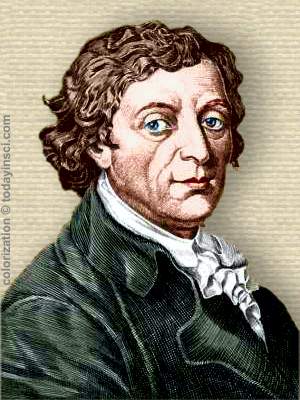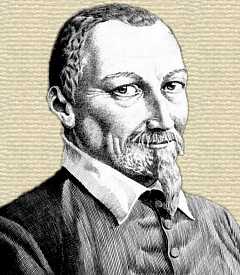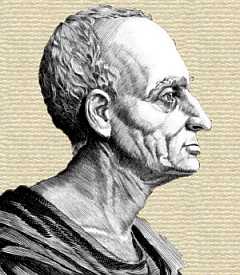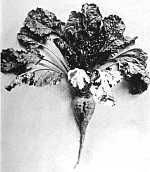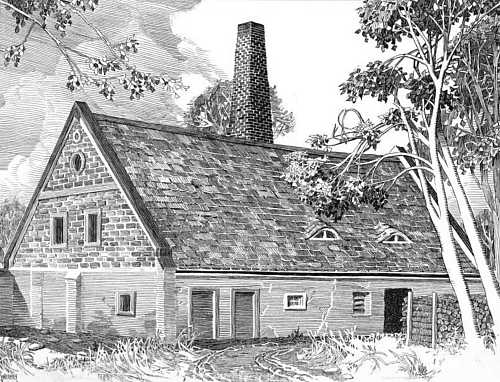 (source)
(source)
|
Franz Karl Achard
(28 Apr 1753 - 20 Apr 1821)
German chemist and experimental physicist who invented a process for the large-scale extraction of table sugar (sucrose) from beets, and in 1801, opened the first sugar-beet factory.
|
Beet Sugar in Europe
from Something About Sugar: Its History, Growth, Manufacture and Distributions (1917)
[p.128] THE destruction of the French fleet by Nelson in 1805 thwarted Napoleon’s long-cherished plans for the invasion of England. Nothing daunted, however, he immediately bent his efforts toward isolating Great Britain and cutting commercial communications between her and the continent of Europe. The Berlin edict of 1806 prohibited all trade relations with England and made her goods and those of her colonies subject to seizure. England’s reply was to forbid ships of all nationalities to enter French ports under penalty of confiscation. Napoleon followed this with the Milan decree which made any vessel that had submitted to English examination or paid dues in English ports subject to confiscation. The one government vied with the other in preying on commerce. The interference with the importation of sugar due to this condition drove prices upward to a point where only a few could afford its use.
Napoleon was fully cognizant of what a privation this was to his people, but he felt confident that means would be found to bring sugar from the Far east to western Europe by way of Constantinople and Vienna; besides, he had strong hopes that a substitute for cane sugar could be produced in Europe itself. He encouraged experimental and research work, keeping thoroughly informed as to progress made, and on March 25, 1811, he issued the famous decree that set in motion the beet industry of the world.
The original home of the sugar beet (Beta vulgaris) is not definitely known. The plant was found in a wild state in southern and middle Asia and it is said to have been cultivated in [p.129] southern Europe and northern Africa in olden times. According to Professor Griffin,1 Herodotus mentions the sugar beet as one of the plants that served to nourish the builders of the pyramids. Dr. von Lippmann cites the same instance and also quotes Voltz as authority for the statement that the Romans first brought the beet into Gaul.
When the beet was originally grown in southern latitudes it was an annual, but when it was taken north it became a biennial, storing sugar the first year and not developing its seed until the second.
Jules Hélot, an eminent French authority, in his “Histoire Centennale du Sucre de Betterave,” says:
“A great French agronomist, called the father of agriculture, Olivier de Serres (1539-1619), was able to find out that the beet-root contained sugar, long before Marggraf set about to extract sugar from this root. Olivier de Serres wrote: ‘The beet-root, when being boiled, yields a juice similar to syrup of sugar, which is beautiful to look at on account of its vermilion color’.”
Dr. von Lippmann, however, contends that Olivier de Serres never claimed in his writings that he discovered the sugar content in the beet, and that the statement “that the boiled juice of the red beet was similar in appearance to sugar syrup” cannot be construed as evidence that de Serres actually recognized the presence of sugar in the beet-root.
In the year 1747 Andreas Marggraf, a chemist and a member of the Royal Academy of Science and Literature of Berlin, demonstrated that various kinds of beet-root contained sugar and that the sugar could be extracted and crystallized. This discovery, however, was regarded for many years as being merely a laboratory determination and without practical value. In 1786 Franz Karl Achard, a pupil of Marggraf, attacked the problem [p.130] of beet-root cultivation and succeeded in extracting sugar from beets on a scale hitherto unknown. He issued a report of the methods employed and the results obtained and stated that a good muscavado sugar should be made from beets for six cents per pound. His claims met with incredulity and no little ridicule, but the French Institute made a careful investigation of what he had done and found that the sugar content of the beets was over 6 per cent. From a number of tests of Achard’s process, they estimated that the cost of producing refined sugar from beet-roots on a commercial basis would be eighteen cents per pound.
Frederick William III, king of Prussia, took a keen interest in the making of sugar from beets, and, after having, convinced himself that Achard was on the right track, he bought the crown land at Cunern, Silesia, for exploitation on a large scale He provided Achard with funds for the erection of the first real sugar factory built in Germany, at which operations were begun in 1802. The king also supplied money for the construction of other factories in Brandenburg, Silesia, and Pomerania, and lent his support to the growers of beets as well as to the manufacturers of sugar. Despite the reverses in war suffered by the Prussians, the progress in sugar making was so manifest that in 1810 it was clear that the industry was bound to succeed under intelligent management.
Achard, who was of French extraction, had corresponded with a number of scientific men in France and through them reports of his work reached the French Institute. The verdict of this body was favorable and two sugar factories were built, one at St. Ouen and the other at Chelles. Both of these enterprises failed through lack of practical knowledge and the inferior quality of the beet-roots. Although this setback brought the manufacture of beet sugar to a standstill for a time, there is plenty of evidence to show that hope of ultimate success was [p.131] never abandoned. The effect of the closing down of these two beet factories was to divert the attention of scientists to making sugar from grapes. Proust and Parmentier, both chemists of note, demonstrated that it could be obtained from this source and the French government issued instructions for the preparation of sugar and syrup from the vine. Parmentier published a bulletin advising against the attempt to make beet sugar in France as the soil of the country would not produce beet-roots containing sugar. In 1810 Napoleon ordered an appropriation of 200,000 francs to be divided as a premium among the factories recovering the highest percentage of sugar from grapes. Meanwhile the friends of the beet movement had not been idle, and early in March, 1811, the Society for the Encouragement of Nationa1 Industry submitted to the emperor a report of what had been accomplished in the manipulation of beets, together with samples of the sugar obtained, and on the 25th of that month Napoleon issued the edict that established the manufacture of beet sugar in France. The decree provided that 79,000 acres of land in various parts of the empire should be devoted to the raising of beets and directed that all the acreage named should be under cultivation the first year, or at latest the second. It created six experimental stations for the instruction of the farmers and land owners in cultivation and also for the furtherance of the interests of the manufacturer.
Delessert had established a factory at Passy in 1801 and by dogged perseverance, despite many failures, obtained excellent results by a new method of darification and the use of charcoal. Napoleon visited his plant in 1812 and ordered the construction of ten new factories at once. On January 1, 1813, al1 further imports of sugar from the East and West Indies were prohibited.
In 1812 and 1813 the output of sugar in France was 2200 tons and the factories of Germany and Austria gave promise of soon supplying the wants of their respective countries. During the [p.132] following two years there were unusually heavy rains and the beet fields of France were occupied by hostile troops. The defeat of Napoleon at Waterloo and the consequent abolition of the blockade caused a decline in the price of sugar to a point where the new beet industry was unable to compete and only one factory succeeded in avoiding the general disaster.
From 1816 to 1821 the average yearly output of beet sugar was 1000 tons. The domestic product had a great advantage: over the foreign article, as all sugars coming into France from abroad were subject to a heavy duty, while no tax was levied on home-grown sugar. In 1821, a duty of 49.5 francs was imposed upon every 100 kilograms (220.4622 lbs.) of raw sugar coming from French colonies and 70 francs on white sugar. The tax on sugar from foreign countries was 90 francs per 100 kilograms, and this was increased to 125 francs in 1829.
Shortly afterward the surtax2 on foreign sugar was increased and an extra duty was exacted on sugar brought into France in foreign bottoms. Even with this protection the domestic producers were not satisfied. French colonial sugar, when exported, received the benefit of customs drawback of 120 francs per 100 kilograms, and the same privilege was accorded home-grown sugar upon which no duty whatever had been paid. This was tantamount to an export premium of 120 francs per 100 kilograms, and it may well be imagined that under this paternal arrangement old factories came back to life and new ones sprang into being. Under this regime by 1836 nearly one-third of the sugar refined in France was beet. The payment of this premium was so great a drain on the government treasury that in 1840 the authorities seriously considered the buying up of all the beet-root sugar factories then in operation for forty million francs and the equalizing of the tax on foreign and domestic sugar. The scheme was not carried out, but in 1843 beet-root [p.133] sugar and cane sugar were placed on the same basis.
1 Quar. Jour. of Economics, Vol. XVII, p. 1.
2 The excess of import duty over the domestic revenue tax.
- Science Quotes by Franz Karl Achard.
- 28 Apr - short biography, births, deaths and events on date of Achard's birth.
